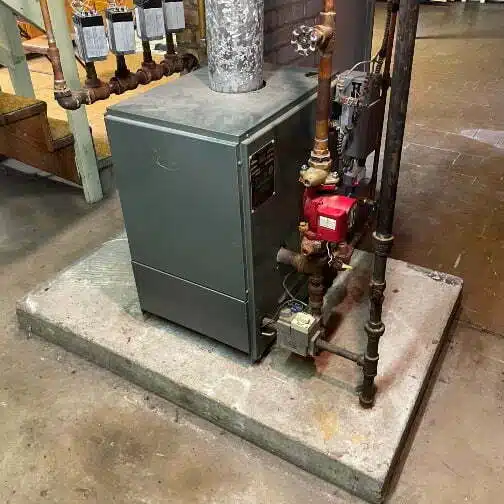heating FAQ
How Do Boilers Work?
Short Answer: A boiler works by burning fuel to heat water, which is then circulated through a system of pipes to radiators or underfloor heating systems. The key components of a boiler include the burner, combustion chamber, heat exchanger, controls, and exhaust stack.

In the cold winters, there’s nothing quite like the feel of a warm, cozy room heated by a boiler. But have you ever wondered how your boiler works? Understanding the inner workings of this essential appliance can help you maintain it better, spot potential issues early on, and ensure it runs efficiently. So, let’s unravel the mystery and find out just how boilers function.
Understanding the Basics
At the most fundamental level, a boiler is a closed vessel or system designed to heat water and convert it into steam or hot water, thus providing a means of heating a dwelling or other building. The term ‘boiler’ comes from an old term for a place where water is boiled. In contemporary usage, though, the term refers to a device that burns fuel to heat water, transforming it into steam or hot water, which is then circulated through pipes to radiators or underfloor heating systems.
Boilers can be found in a wide array of settings, from residential homes and commercial offices to large factories and industrial sites. They’re also a vital component in the operation of some ships and locomotives, providing the heat and steam necessary for their operations. Understanding how these boilers work, regardless of their specific application, requires knowledge of the key parts and their functions.
The Core Components of a Boiler
Before we dive into the specifics of how a boiler operates, it’s important to familiarize ourselves with its core components. Much like how an orchestra is composed of various instruments, each with its unique role, a boiler is made up of several parts, each contributing to its overall functionality.
- Burner: The burner is where the fuel (like natural gas, propane, or oil) is mixed with air and ignited, producing a flame.
- Combustion Chamber: This is where the burning fuel heats the water. The combustion chamber must withstand high temperatures and be properly sealed to prevent gas leaks.
- Heat Exchanger: The heat exchanger is essentially a pipe or a series of pipes where the heat from the burning fuel transfers to the water.
- Controls: These include thermostats, pressure controls, and safety valves. They help monitor and control the boiler’s operation to ensure optimal performance and safety.
- Exhaust Stack: Also known as the flue, it is a pipe that carries away exhaust gases from the combustion process.
Boiler Operation – Step-by-Step
Now that we’re familiar with the different components of a boiler, let’s go on a journey within the boiler itself. Picture yourself as a droplet of water making its way through the system. This step-by-step guide to the boiler operation will help us understand how each component interacts with others to bring heat into our homes and offices.
- When your room temperature drops below the thermostat setting, the boiler is triggered.
- The burner is supplied with fuel and ignites.
- Inside the combustion chamber, the ignited fuel produces heat.
- The heat is then transferred to the water through the heat exchanger, turning the water into steam or hot water.
- This heated water or steam travels via pipes to radiators or other heating systems, distributing warmth around your home or building.
- Finally, any exhaust gases produced in the combustion process are expelled safely through the flue.
Types of Boilers
Different types of boilers have different features:
- Combination Boilers: These are compact, efficient units that provide both heating and hot water directly from the boiler, eliminating the need for a separate water tank.
- System Boilers: They require a storage tank for hot water but are known for their ability to deliver a steady supply of hot water to multiple taps at once.
- Conventional Boilers: These traditional boilers require both a cold water tank and a hot water storage cylinder, typically installed in lofts or airing cupboards.
How Boiler Efficiency is Measured
Boiler efficiency is a measure of how effectively the boiler converts fuel into heat. It’s usually expressed as a percentage – the higher the percentage, the more efficient the boiler. The boiler’s efficiency rating can be influenced by several factors, including its age, type, and maintenance schedule.
Boiler Maintenance and Safety
Regular maintenance is key to ensuring your boiler works efficiently and safely. Scheduling annual services with a professional technician can keep your boiler in top condition and help spot issues early. It’s also crucial to ensure that the area around the boiler is kept clean and free from any potential obstructions.
As for safety, remember that boilers involve combustion and can produce harmful gases like carbon monoxide. Therefore, always have a working carbon monoxide detector installed in your home. If you suspect a gas leak or other boiler-related issue, contact a professional immediately.
Conclusion
Boilers, often taken for granted, are workhorse appliances that play a pivotal role in our comfort during those chilly months. Understanding how a boiler operates not only satisfies our curiosity but also helps us better maintain our heating systems, ensuring they run optimally and safely. The intricate dance of components like the burner, combustion chamber, heat exchanger, and controls, together with the boiler’s different types and efficiency measurements, reveal a sophisticated and invaluable piece of technology in our homes.
Remember, while it’s essential to know the basics, handling your boiler’s maintenance, repairs, and safety checks should always be left to a professional. Stay warm, stay safe, and appreciate the silent comfort that your boiler provides.
